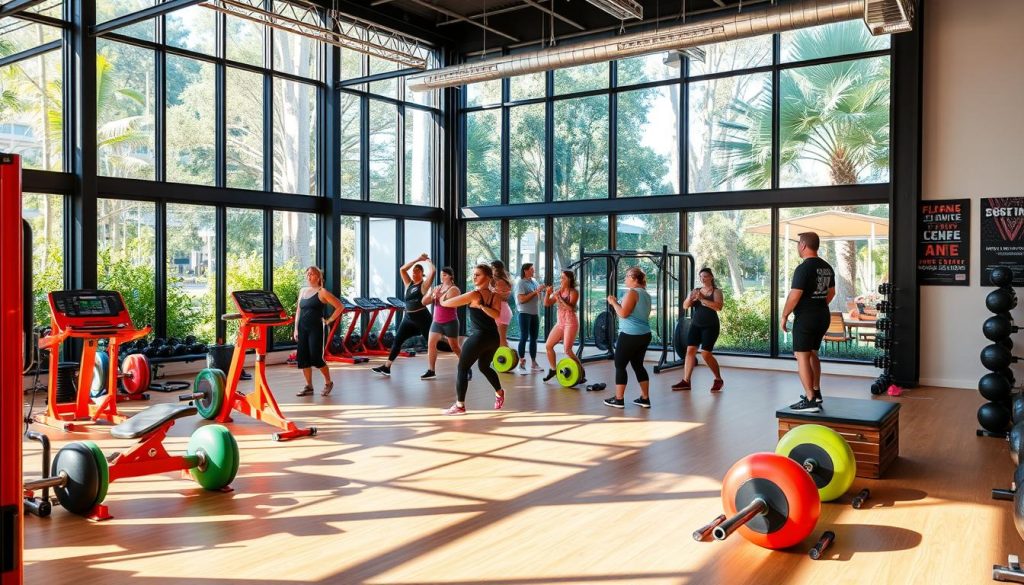The fitness industry in Australia is booming, attracting many who want to start their own business. This guide is here to help you understand the basics of starting a fitness business. It covers the market trends and rules you need to know.
With a growing need for fitness services, starting a business can be a great move. This guide will help you through the challenges of starting up. You’ll be ready to make a splash in this exciting field.
Understanding the Fitness Industry in Australia

The fitness industry in Australia is very diverse. It includes traditional gyms, personal training, boutique studios, yoga, and wellness centres. Over the last decade, it has grown a lot, showing big changes in these areas.
People now want fitness experiences that are personal and special. This is why boutique studios are becoming more popular. They offer unique settings and workouts made just for you. Also, digital fitness options are becoming more common. They give people the flexibility to work out whenever they want.
This change in the fitness world shows how people’s views on health and wellness are changing. Looking at the fitness services available, we see more demand for new and exciting things. This means fitness businesses need to keep up and offer what people want.
Key Considerations Before Starting Your Fitness Business

Starting a fitness business needs careful thought and insight into many factors. It’s important to understand your personal reasons and passion for fitness. This self-reflection helps shape your business’s direction.
Looking at the business world is also crucial. Doing market research helps find out who your competitors are and what services are missing. This is key to knowing if your idea will work.
- Knowing who your target audience is helps focus your marketing.
- Local demand affects your pricing and what services to offer.
- Keeping up with fitness trends helps you position your business well.
Studies show that knowing your goals and audience well boosts your chances of success. Making informed decisions from the start sets you up for long-term success in fitness.
How to Start a Fitness Business in Australia

Starting a fitness business in Australia needs a good grasp of the current market. Knowing where your services fit in is key. By focusing on a specific niche, like personalised fitness, you can stand out. Doing thorough research helps you create services that meet unique market needs.
Identifying Your Niche in the Market
Finding a unique spot in the fitness market is vital. A deep dive into the market can reveal areas where you can offer something new. Your services could include:
- High-intensity interval training
- Wellness coaching
- Yoga or Pilates classes for specific groups
- Virtual training for clients who can’t come to you
Successful businesses use fitness trends to shape their plans. They keep an eye on what customers want to attract the right people.
Conducting Market Research
Good market research is key to understanding what people want. You can use:
- Surveys to find out what potential clients are looking for
- Focus groups for deeper insights
- Looking at what competitors do well
This way of working helps businesses make their services better and their marketing more effective. Companies that base their plans on solid research can handle the market’s ups and downs better.
Developing a Business Plan for Your Fitness Business

Creating a solid fitness business plan is key to success. It outlines your goals and how to reach them. This plan is the backbone of your business.
Begin by setting out your vision and mission. Explain what your business is about and where it’s headed. This helps shape your brand and draw in customers.
Then, include financial forecasts. Show what you expect to earn and spend. Good financial planning is vital for growth and keeping your business running.
Don’t forget to detail how your business will operate every day. Talk about your staff, services, and how you’ll engage with customers.
Research shows that well-planned businesses do better than others. To help, many resources offer templates for fitness business plans.
Choosing the Right Business Structure

Choosing the right business structure is key for any fitness venture in Australia. Each structure has its own legal rules, tax duties, and rules to follow. Knowing these differences helps entrepreneurs make the best choice for their business.
Understanding Different Business Structures
In Australia, there are several main business structures. Each has its own good points and downsides:
- Sole Trader: This is the simplest form, letting one person run a business alone. Sole traders have full control but risk losing personal assets if the business fails.
- Partnership: Partnerships are for two or more people. They share profits, losses, and decisions. Partnerships offer shared skills but can lead to disagreements, so clear agreements are crucial.
- Company Registration: A limited liability company protects personal assets. It’s more complex, needing to follow rules and possibly costing money for registration.
Deciding on a business structure in Australia needs careful thought. Each option affects taxes and legal duties differently. Entrepreneurs must weigh their needs and goals before making a choice.
Registering Your Fitness Business

To start a fitness business in Australia, you need a clear business registration process. This makes your business official and follows local laws. Getting an Australian Business Number (ABN) is key. It’s a unique ID for your business with the Australian Taxation Office and other agencies.
Picking a good business name is also important. The name should be unique and match your business type. After choosing, you must register it with your state or territory.
In short, following the business registration steps is crucial for success. With your ABN and name registered, you can concentrate on running your business smoothly.
Securing Funding for Your Fitness Venture

Starting a fitness business needs money, and knowing where to find it is key. Entrepreneurs should look into different ways to fund their business. Options include personal savings, bank loans, and grants for fitness businesses. Venture capitalists can also offer the money needed for growth.
Exploring Start-Up Funding Options
When looking at start-up loans, there are several choices:
- Personal Savings: Using your own money shows you’re serious and can lay a solid base for your business.
- Bank Loans: Banks need a good plan and your credit score, but they can give a lot of money.
- Grants for Fitness Businesses: These are free money from governments or private groups for health and fitness projects.
- Venture Capital Investment: Getting investors who care about fitness can give you money and advice.
It’s important to present your fitness idea well to lenders or investors. A clear plan, market research, and how you’ll make money can help get the funding you need. Looking at successful fitness businesses can inspire and guide you through this crucial step.
Choosing the Perfect Location

Choosing the right spot for a fitness business is key to success. A detailed site analysis helps find the best place to attract customers. Important factors like how easy it is to get to, how visible it is, and what’s nearby are crucial.
Looking at these points and the local people helps understand who might join. This gives valuable insights into the potential customer base.
Factors Influencing Location Choice
When picking a spot for a fitness business, several things matter. These include:
- Foot Traffic: Being in a busy area can draw more people in.
- Proximity to Competitors: Knowing who else is around helps plan your spot.
- Demographic Factors: Studying the local area shows who might be interested in fitness.
- Accessibility: Easy transport options bring in more visitors.
- Size and Layout: Enough room for gear and classes is vital for running smoothly.
Doing deep research on these points helps make smart choices. These choices should match the fitness business’s big picture.
Marketing Your Fitness Business Effectively

Marketing your fitness business well is key in a competitive world. Using digital marketing can really help you stand out. Social media is great for reaching your audience with fun and interactive content.
Utilising Social Media Platforms
Choosing the right social media is important. Instagram and Facebook are good for fitness content. Share great posts, videos, and live sessions to build a community.
Post fitness tips, client success stories, and special offers often. This helps grow your business. Studies show active online businesses get more members and keep them longer.
Creating an Engaging Website
Your website is crucial for your online image. Make it easy to use and look good. It should have clear info, booking options, and testimonials.
Showcase your success stories and facilities to build trust. A professional website boosts your visibility and credibility. It encourages people to join your gym.
Hiring Qualified Staff for Your Fitness Business

The success of any fitness business depends a lot on its staff quality. Good fitness staff recruitment is key to having a great team. By hiring qualified trainers, you improve customer satisfaction and keep them coming back.
To build strong hiring policies in fitness, try these strategies:
- Conduct competency-based interviews to gauge the practical skills and knowledge of candidates.
- Verify credentials and qualifications to ensure trainers meet industry standards.
- Implement trial sessions where potential hires can demonstrate their capabilities in a live setting.
- Offer ongoing professional development opportunities to foster growth and excellence among staff.
Studies show that knowledgeable staff make a big difference in customer experience. Spending time and resources on good recruitment means your clients get the best service. This boosts your business’s reputation in the competitive fitness market.
Legal Requirements and Compliance

Starting a fitness business means you have to follow many legal rules, especially about health and safety. It’s key to know these rules well to keep your business in line. This part will cover the important bits like certifications, insurance, and safety steps to keep everyone safe.
Understanding Health and Safety Regulations
In Australia, following health rules is a must for any fitness business. These rules help keep clients and staff safe. Important things to think about include:
- Getting the right certifications, like first aid and CPR.
- Keeping facilities safe, including checking equipment and keeping places clean.
- Creating plans to manage risks and avoid dangers.
- Having the right insurance to cover any problems.
Safe Work Australia has great resources for fitness business owners. They help with setting up and keeping up safety standards. Keeping up with health rule changes in Australia is also important for staying compliant.
Building a Community Around Your Fitness Brand
Creating a lively fitness community is key for keeping clients engaged and loyal. Hosting local events or fitness challenges is a great way to do this. It brings people together, fostering friendship and fun.
These events make clients feel connected to your brand in a special way. They create lasting memories that clients cherish.
Setting up loyalty programmes is another smart move. It rewards clients for coming back or bringing in new members. This makes them feel valued and more likely to stay with your brand.
Listening to what your clients say is also important. It shows you care about their thoughts and opinions. This strengthens their bond with your brand.
Creating a space where clients feel seen and heard boosts community spirit. Studies show that brands with strong community ties get more loyal customers. So, taking the time to connect with your clients pays off in many ways.
















